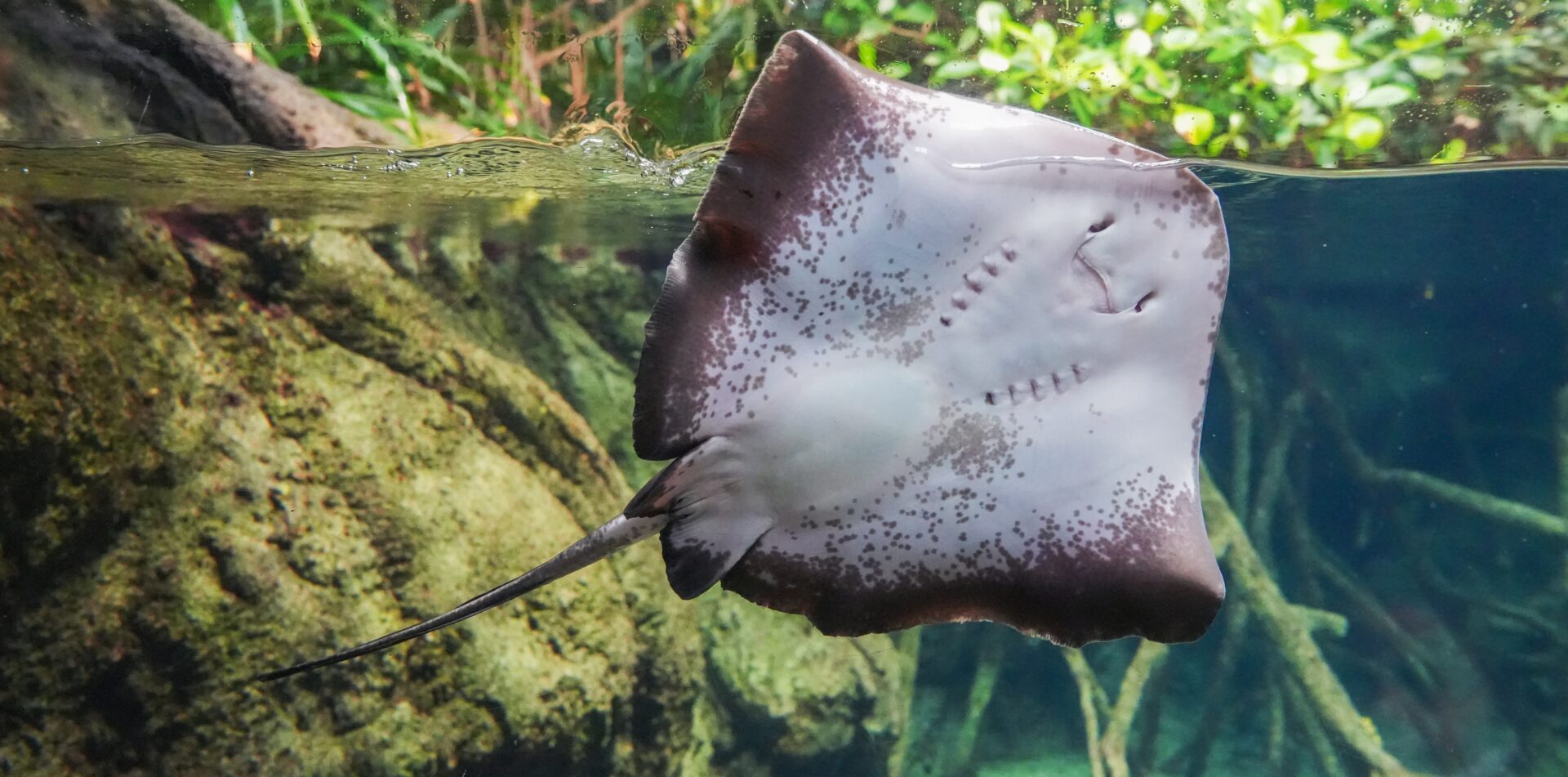The moon hanging low over the Pacific, casting a silvery glow on the water. The ocean comes alive with hide and seek of the moonlight with clouds. The mood is relaxed but excited in anticipation of – what this darkness may reveal. You start breathing deep and slowly but more focused as you await an encounter with the Ballerinas of the ocean or you can call it – The devil fish. You slip into your wetsuit, adjust your snorkel mask, and step onto the boat. You’re now on a journey from a daily boring life to a better world experience : Night Swim with Manta rays Kona, Big Island
In this blog, We’ll share our personal experience, practical tips, and the best tour operators for an unforgettable manta ray snorkeling encounter.

Introduction
The Big Island of Hawaii is a paradise for adventure lovers. The largest of the Hawaiian islands, the aptly named Big Island is a full package of natural beauties. It’s towering volcanoes, Black sand beaches, snow covered mountains, and thriving coral reefs make a heaven on Earth. The Big Island has something for everyone – from hiking and surfing to stargazing and snorkeling. Among its many wonders, ‘Night Swim with Manta rays Kona Big Island‘ stands out as an unforgettable experience. Getting the chance to swim with these gentle giants is once-in-a-lifetime experience.
Why Night Swim with Manta rays Kona Big Island?
Manta rays, also known as “Devil rays,” are large rays belonging to the genus Mobula. ‘Manta’ means blanket or cloak in Spanish. It has a large, flat, diamond-shaped body, and two horn-shaped fins extending from the front of their heads, which has also given them the nickname devil fish. They can grow up to 13 feet long and weigh over 3,000 pounds. Despite their size, they are docile, harmless, and curious creatures. Their nightly ritual involves feasting on plankton, which makes the Big Island an ideal location for encounters.
Here’s why you should consider a manta ray night swim:
- Otherworldly Experience: Imagine floating in the illuminated underwater lights and these majestic rays glide silently around you.
- Unique Feeding Behavior: Witnessing manta rays somersaulting through the water, mouths wide open, filtering plankton. It is a sight you won’t soon forget.
- Close Encounters: Unlike many marine creatures, manta rays are curious and often approach snorkelers and divers, allowing for up-close interactions.
When to go
The best time to Manta ray snorkeling in Hawaii is at night when they are most active feeding on plankton. Though you may go year-round, The peak manta ray season is typically May through October. During these months, the water is warmer and there may be more plankton on the surface of the water. Your best chance of seeing mantas is during a new moon when it’s darker and easier for them to spot the plankton that attracts them to the surface.
Where to Find Manta Rays
Three locations on the Big Island offer excellent opportunities to swim with manta rays:
- Manta Village (South of Kona):
- The original manta ray night dive location
- Located off the coast from the Sheraton Keauhou Bay
- Prepare for an enchanting experience as the mantas glide beneath you
- Manta Heaven (North of Kona):
- Another popular spot for manta ray encounters
- The Kohala Coast near Waikoloa is home to these gentle giants.
- Dive into the dark waters and witness their mesmerizing ballet
- Keauhou Bay:
- Sea Paradise offers guided night snorkel tours here
- If you don’t see mantas, they invite you to return for free
- Kids aged 6 and above are welcome to join the adventure
Best tour operators
Certainly! If you’re looking for private tours in Hawaii, here are some options to consider:
- Manta Ray Dives of Hawaii:
- Location: Kailua-Kona, Big Island
- Description: A family-owned company providing the best Ecoadventures along the Kona coast. They offer manta ray snorkeling and diving experiences, as well as wildlife eco-adventures.
- Notable Features:
- Listed as a preferred tour company on the Hawaii Ocean Watch Green List.
- Reputable and experienced since 1985.
- Spacious luxury catamaran, Hoku Nui, for a comfortable experience.
- Website: Manta Ray Dives of Hawaii
- Sea Quest Hawaii:
- Location: Kailua Kona, Big Island
- Description: Explore sea caves, lava tubes, and observe dolphins and whales in their natural habitat. Small-group snorkel tours designed for an intimate and unique adventure.
- Notable Features:
- Offers pristine reef snorkeling along the rugged Kona Coast.
- US Coast Guard licensed captain shares rich history and legends.
- Over 30 years of specialized snorkel tours.
- Website: Sea Quest Hawaii
- Kona Snorkel Trips:
- Location: Kailua Kona, Big Island
- Description: Specializing in fun, they focus on ensuring you have a great time on the water. Features the world-famous manta ray snorkel and swimming with dolphins.
- Notable Features:
- Top activities in Kona.
- Reputable and experienced.
- Website: Kona Snorkel Trips
- Sea Paradise:
- Location: Kailua Kona, Hawaii.
- Specialty: Manta ray night snorkeling.
- Experience: Witness the majestic manta rays up close as they glide gracefully through the water.
- Guided Tours: Sea Paradise offers guided tours with knowledgeable staff to ensure a safe and memorable adventure.
- Website: seaparadise.com
Manta Ray Night Dive vs. Manta Ray Night Snorkel
The choice between diving and snorkeling depends on your comfort level:
- Diving:
- Sit on the ocean floor and look up
- Observe the manta rays from a different perspective
- Recommended for expert swimmers and divers
- Snorkeling:
- Stay near the water surface
- Hold a flotation device with attached lights to attract plankton and manta rays
- Ideal for those who are not expert in swimming
Preparing for the Snorkel
Night snorkeling is different than during the day, so come prepared. You’ll want to wear a wetsuit for warmth, as the water can get chilly after sunset. A dive light is also essential for illuminating your surroundings once the sunlight fades.
Before heading out, make sure your mask, snorkel, and fins are in good shape and fit properly. Foggy masks and leaky snorkels are annoying at best and dangerous at worst. Your snorkeling guide should provide all necessary gear if you don’t have your own.
While waiting to get in the water, keep an eye out for mantas from the boat. Their unique triangular shape and whale-like mouths are easy to recognize as they gracefully glide by.
Swim with Manta rays
- Once the boat arrives at a good spot, the captain will give the all clear to enter the water slowly and quietly. Giant manta rays are shy creatures and easily startled by loud splashing
- Your guide will have lights set up to attract plankton, but bring your dive light and keep it handy. The best approach is to stay still, relax, and watch the rays move around you.
- Seeing manta rays feed is an amazing sight. As they swim along, they perform barrel rolls to take in large gulps of plankton-filled water. Being in the midst of their acrobatic feeding is thrilling
- Mantas move gracefully and are harmless to humans, so there’s no need to feel afraid. But do not try to touch or chase after them. Give them plenty of space
Tips and precautions
Remember, Night Swim with Manta rays at Kona, Big Island is a privilege. Follow guidelines, appreciate their beauty, and create lasting memories. Follow these tips when swimming with manta rays:
- Safety First: Assess water conditions before entering. High surf, strong winds are not ideal for snorkeling. Always enjoy this adventure with a buddy.
- No Touching: Do not feed, splash, or touch Manta rays. This can alter their natural behavior
- Year-Round Sighting: Be it any season. Manta rays are locals; they show up for dinner at their feeding grounds
- Be Patient: While sightings are common, there’s no guarantee. Tour operators usually offer re-booking or discounts if no mantas appear.
- Gear Safety: Be sure to rinse your gear properly with freshwater to wash away any salt residue that could damage equipment.
- Photography: Avoid using flash photography, Capture memories without disturbing them.
- Respect and Admire: The giant manta ray is listed as threatened under the Endangered Species Act (ESA). They deserve our respect and admiration.
Conclusion
So that wraps up our amazing experience to swim with manta rays off the Kona coast of the Big Island! I know it probably sounds scary to jump into open ocean at night with these giant creatures, but it was truly magical. The mantas were so graceful and harmless, and to see them so close like that is something We’ll never forget.
Have any of you done a night snorkel with mantas before? If not, we highly recommend adding it to your Hawaii bucket list. Our whole experience was just surreal and breathtaking. Let us know in the comments below if you have any queries about Manta rays or snorkel tour on the Big Island! We are happy to provide recommendations on the best spots and tour operators. Mahalo nui loa for reading! Happy Snorkeling!
FAQs: Night Swim with Manta rays Kona Big Island
Here are some sample frequently asked questions (FAQs):
Q: When is the best time of year to Night Swim with Manta rays Kona Big Island in Hawaii?
A: The best time to see manta rays around the Big Island is between May and October when the plankton levels are higher, attracting more mantas nearshore to feed. But it’s possible to spot them year-round.
Q: Where are the best places to swim with manta rays in Hawaii?
A: Some of the top spots are off the Kona Coast, Keauhou Bay, and the northern tip of the Big Island near Kawaihae Harbor. These areas have cleanup lights that attract plankton, mantas’ main food source.
Q: What should I wear and bring for a manta ray night snorkel?
A: Wear a wetsuit for warmth and comfort. Bring a mask, snorkel, fins, waterproof flashlight or dive light, a flotation device if needed, and reef-safe sunscreen. A GoPro or underwater camera is great for photos too!
Q: Is Night Swim with Manta rays Kona, Big Island safe?
A: Yes, manta ray night snorkels are very safe. Mantas are gentle, placid creatures who get used to swimmers. Just give them space, don’t chase or touch them. The main hazard is boat traffic at night.
Q: How close can I get to a manta ray while snorkeling?
A: It varies, but mantas may come within a few feet of you! Often they glide right over your head. It’s an incredible feeling having these giant peaceful creatures swim close by

